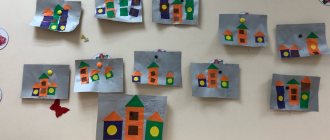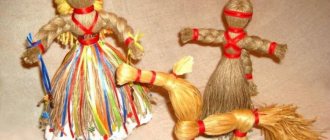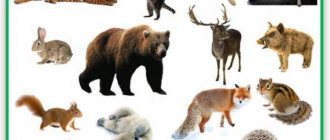Progress of the lesson:
Educator: - Guys, the holiday “ Cosmonautics
", which is celebrated on April 12.
The first manned space
occurred in 1861.
What was the name of the first person who flew into space
?
Yuri Gagarin (children's answers)
.
Educator: -Yes, his name was Yuri Gagarin. Tell me, what did he fly into space on?
?
On a rocket
(children's answers)
.
Educator: - That's right, on a rocket
.
He boarded
the Vostok-1
spacecraft space
.
The launch
of the ship took place from
the Baikonur Cosmodrome
.
Educator: - Guys, in space
Yuri Gagarin saw the planets. What planets were these?
—(children list the names of the planets)
.
Educator: -What is the name of the planet on which we live?
Earth (children's answers)
.
Educator: - That's right guys - this is planet Earth! Look what it looks like. (Globe display)
.
Children look at the globe.
Educator: - Guys, now we will color the diagram of the Earth. Please note where the number 1 should be painted over in blue, and where the number 2 should be painted over in green.
Children complete the task.
Educator: - Well done! Everyone completed the task. Now we take scissors and cut out our diagrams along the contour.
Children complete the task.
Educator: - Excellent! Your planet Earth turned out beautiful and neat! Now we take the diagram of the Earth and paste it onto the space orbit
.
Children complete the task.
Educator: - Guys, tell me, what is missing in our orbit?
- rockets
(children's answers)
.
Educator: - Of course, rockets
!.You have different geometric shapes on your table.
Make a rocket
.
Children complete the task.
Educator: Well done! So, your spaceships
,we will glue it.
Take a silver rectangle - this is the rocket
without a nose and glue it to our orbit at an angle as if
a rocket were flying into space
.
Take the big triangle - this is the nose of the rocket
, which we glue above the body rectangle.
Take a square and cut it diagonally into two triangles. These are the wings of a rocket
-glue on the sides of the body
(bottom)
.
We take 2 circles - these are the rocket
rocket
body itself , into which
the astronaut
.
Take 2 orange diamonds and paste them below the rocket body - this is fire
, which flies out of the
rocket
.
Children perform the task to the music.
Educator: Well done! Look at your rockets
went on a flight into
space
!
Guys, when an astronaut
looks out the window, what does he see?
Planets, stars (children's answers)
.
Educator: -Take the stars on the table and stick them on your orbits!
Children stick on stars.
Educator: - Guys, look how beautiful the work turned out. missiles do we have?
!
After completing the work, the children lay out their compositions on the table. They look at it and exchange impressions.
Publications on the topic:
On April 12, our country celebrates a wonderful holiday - Cosmonautics Day! People have dreamed about space since ancient times. They carried this dream forward.
Educational field - artistic and aesthetic development. Topic: Application from improvised material “Monkey” Author S. V. Bukhankova, teacher.
Hello colleagues! On April 12, we celebrated the 55th anniversary of the first cosmonaut's flight into outer space! On this wonderful occasion in our...
Summary of GCD for an integrated lesson: application “A rocket flies into the sky” in the middle group Goal: to expand and consolidate knowledge about space and astronauts. Objectives: Teach children to make a rocket from geometric shapes, correctly naming:.
Program content: Educational: - introduce the main planets - give basic concepts about the planets - teach independently.
“Rocket” – GCD for paper construction
Smirnova Irina Grigorievna Tregubova Larisa Viktorovna Grebenikova Tatyana Alekseevna educators MBDOU "Kindergarten of the village of Tomarovka of the Yakovlevsky urban district"
The material was sent for publication in the All-Russian printed collection of practice-oriented materials “Preschool and primary education - modern methods and technologies of teaching and upbringing” - July-August 2022.
ROCKET NOD in the senior group - paper construction
Goal: to expand children's understanding of space. To develop the ability to create a three-dimensional design of paper rockets using a diagram and a sample.
Advertising message
Tasks:
- Educational: consolidate the names of geometric shapes: circle, rectangle, triangle; construction parts: cone, cylinder, cube. Teach children how to twist a rectangle into a cylinder, a circle into a cone.
- Developmental: develop design skills, the ability to convey the expressiveness of a composition, using the features of paper as a design material. Develop spatial thinking, imagination, and the ability to make inferences. Form a critical attitude towards your actions, objectively evaluate your work and the work of your comrades.
- Educational: to cultivate interest in paper construction. To cultivate accuracy in working with glue and scissors, independence, and initiative. Cultivate a desire to help a friend.
Integration of educational areas : Speech development, cognitive development, artistic and aesthetic development.
Enrichment and activation of the dictionary: Space, cosmodrome, planets, astronaut, orbit, body, nozzles, porthole, design bureau.
Methods and techniques: game problem situation, riddle, conversation - dialogue, looking at illustrations, outdoor play, verbal play, productive activity of children, self-analysis of work, summing up - reflection.
Equipment: a letter asking for help, illustrations depicting rockets, a sample of a finished rocket, parts of a three-dimensional construction set, an audio recording of space music.
Handouts: rocket design diagrams, cardboard, colored paper, scissors, glue, napkins, oilcloth.
Progress of continuous educational activities:
Cheerful music plays and children join the group.
Educator: Guys, today we have guests, let's say hello and invite them to come.
Children: hello!
Educator:
We will all stand in a circle together, You are my friend and I am your friend, Let’s hold hands tightly and smile at each other.
The teacher makes a riddle about space.
Educator: Guys, it’s not in vain that we started talking about space! Today our group received a letter asking for help. Shall we read it? (Yes!)
Educator: Dear guys! Soon there will be an epidemic on the planet “Zhelezyaka”! All the rockets and aircraft here have broken down, and the robots cannot make their flights. Help!
Guys, let's help the robots from the planet "Zhelezyaka"? How can we help robots?
Children's answers: Make rockets and launch them into space onto the planet.
Educator: Can you?
Children: Yes!
Educator: Who creates rockets? (designers, engineers)
Educator: today I suggest you be designers and design rockets for the inhabitants of the planet “Zhelezyaka”. I, as the chief designer, propose to consider rockets (there are illustrations of rockets on the easel)
Next, children examine a sample of a finished rocket made of colored paper and cardboard.
Educator: What parts is the rocket made of?
Children's answers: The nose of the rocket is made of a cone, the main part - the body - is made of a cylinder, the nozzles are made of triangles, the windows are made of circles.
Educator: but before you start creating rockets, do you want to play? (Yes!)
Outdoor game “Lay out the details of the construction set”
Children are divided into two teams and come up with a cosmic name for their team. Countdown: 3, 2, 1 – Start!
After the game, the teacher says that creating a rocket is a difficult and responsible job. You can pair up, agree on who will do what, and help each other.
Educator: please go to the design bureau!
Repetition of the rules for working with scissors and glue.
- Scissors must not be left open.
- You should not bring scissors close to your face.
- Pass the scissors to each other with the rings first, not the tip.
- Handle the glue carefully.
Look how many dangerous objects are lying around! If you do not follow safety precautions, you can injure yourself or a neighbor!
Educator: Guys, we have a problem! As you already said, to design a rocket you need a cone and a cylinder, we don’t have them.
But there is a design scheme. She will help us.
Look at it carefully and tell me, from what geometric figure can you get a large cylinder?
Children's answers: from a large rectangle, twisting it into a cylinder - a rocket body; from the circle, twisting it - the nose part. We attach the airlocks - triangles, and the portholes - circles to the body.
Educator: It's time to get to work (on the tables there is a set of geometric shapes for each child - a large rectangle, a circle, two triangles, small circles for portholes). During the activity, the teacher provides individual assistance.
Children place finished rockets in one line at the Mechta cosmodrome
Presentation of finished works
Educator: What beautiful rockets you have made, but can all rockets fly to the planet “Zhelezyaka”?
I'll give you one gold star. This is your voice. You will give it away - vote for your favorite work - (put a star next to the rocket).
Which rocket gets the most stars will be considered the best. (This is how children perform visual analysis of work)
Educator: Well done designers! Everyone did it! Will the inhabitants of the planet “Zhelezyaka” like your rockets? (Yes!). Applause!
Educator: Guys, I’m wondering
- -What are people called who fly into space on spaceships? (astronauts)
- -What was the name of the world's first astronaut? (Yuri Gagarin)
- -What was the name of the ship that lifted him into the sky? ("East")
Guys, do any of you want to become an astronaut?
To become an astronaut, what qualities do you need to have? (to be strong, courageous, resilient, responsible)
Educator: You are right, but astronauts must also follow the rules.
Word game "Space rules"
- If you want to become an astronaut, you must know a lot, a lot...!
- Any space route is open to those who love... work.
- Only friendly starships can take with them…on a flight.
- We will not take the boring, gloomy and angry into… orbits.
- Our main rule is to carry out any... order
- Fast rockets are waiting for us to fly to... planets.
- Whichever one we want, that’s the one… we’ll fly.
Let's train like astronauts and fly. I think that now the robots from the planet “Zhelezyaka” will invite us to visit.
Reflection: Guys, what did we do today? Who did they help? What games did you play? Was it difficult for you? What was the most difficult thing? What did you like most? Children's answers.
Literature:
- Kutsakova L.V. Construction and manual labor in kindergarten: Program and lesson notes M: TC Sfera, 2022. – 341 p.
You can see the table of authors and learn more about the collections HERE
Summary of a lesson on application in the senior group “Flight to the Stars”
Program content:
Expand children's knowledge about space and space flights; activate the vocabulary: space, stars, starship, astronomy; develop symmetrical cutting skills from a sheet of paper folded in half; develop in children a sense of composition, teach how to harmoniously place details on a sheet of paper, and learn how to decorate their work.
Materials and equipment:
Audio recording “Look at the stars” (Gr. AIR), strobe light, sheets of black cardboard, templates of silhouettes of different spaceships, colored paper, pencils, scissors, glue, glue brushes, pieces of foil, sequins, sparkles.
Progress of the lesson:
At the beginning of the lesson, children are invited to go on a space journey. The windows in the room are darkened, a strobe light and audio recording are turned on. Children sit on the floor on cushions. If you have a media projector, you can display an image of outer space on the screen. After playing the audio recording, the teacher conducts a conversation.
Educator: Guys, did you like the music? How did you feel, what was it like?
Sample answers from children: Space travel, flight into space.
Educator: Correct. Guys. Do you know that the science of astronomy deals with the study of space? From the ancient language “aster” is translated as “star”. And today we will build our own spaceships and also go on a real space journey! But first we will play with you!
Children stand in a circle, facing the center and repeat the movements and words after the teacher.
Our magical spaceship is setting off! (Children fold their hands into a mouthpiece in front of their mouths and walk around the group in different directions.)
Put on your spacesuits quickly! (Stop and imitate movements.)
take your seats quickly! (They scatter and sit down.)
We take off from the cosmodrome and fly straight to the stars! (They stand up, raise their arms up through their sides, and connect them above their head. Jump up.)
Let's fly, fly, we've reached the Star! (They run, then stop.)
We walked around, looked and flew back. (They walk around the group in different directions, then stop at the cosmodrome landmark.)
After the outdoor game, the teacher invites the children to the tables and reminds them of the rules of conduct during applique classes. We have everything ready. But before we hit the road, we'll stretch our fingers:
Now I’ll look at the sky through a huge telescope (children look through the folded fingers of both hands with their right eyes)
and see something that I would not have been able to see before (look through the folded fingers of both hands with the left eye)
I see stars and planets, asteroids, comets, I see satellites of the planets (children bend their fingers)
It's a pity there are no flying saucers in this telescope! (look through the telescope alternately with the left and right eyes)
After finger gymnastics, the children get to work.
Stages of work:
1. Choose the color of your future starship and its shape template. Fold a sheet of colored paper in half and trace the template. Cut along the contour. We also prepare portholes, antennas and other decorative details according to the child’s design.
2. Place the applique blank on a sheet of black cardboard, glue on the starship and decorative elements.
3. Children decorate the applique with sparkles, sequins and pieces of foil to imitate stars, asteroids, and the milky way.
After the lesson, an exhibition and discussion of the work is organized, where all children can talk about their craft.





